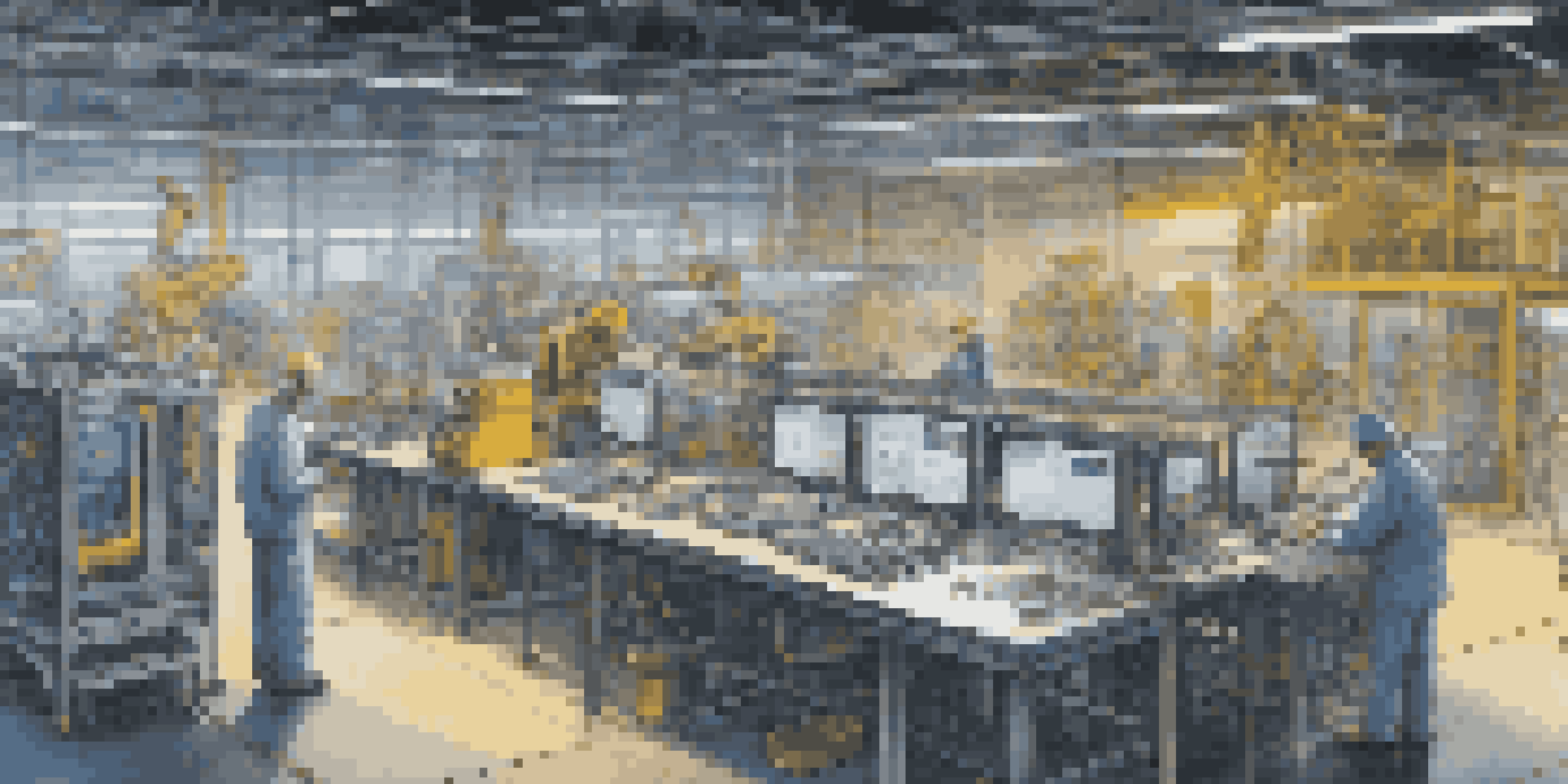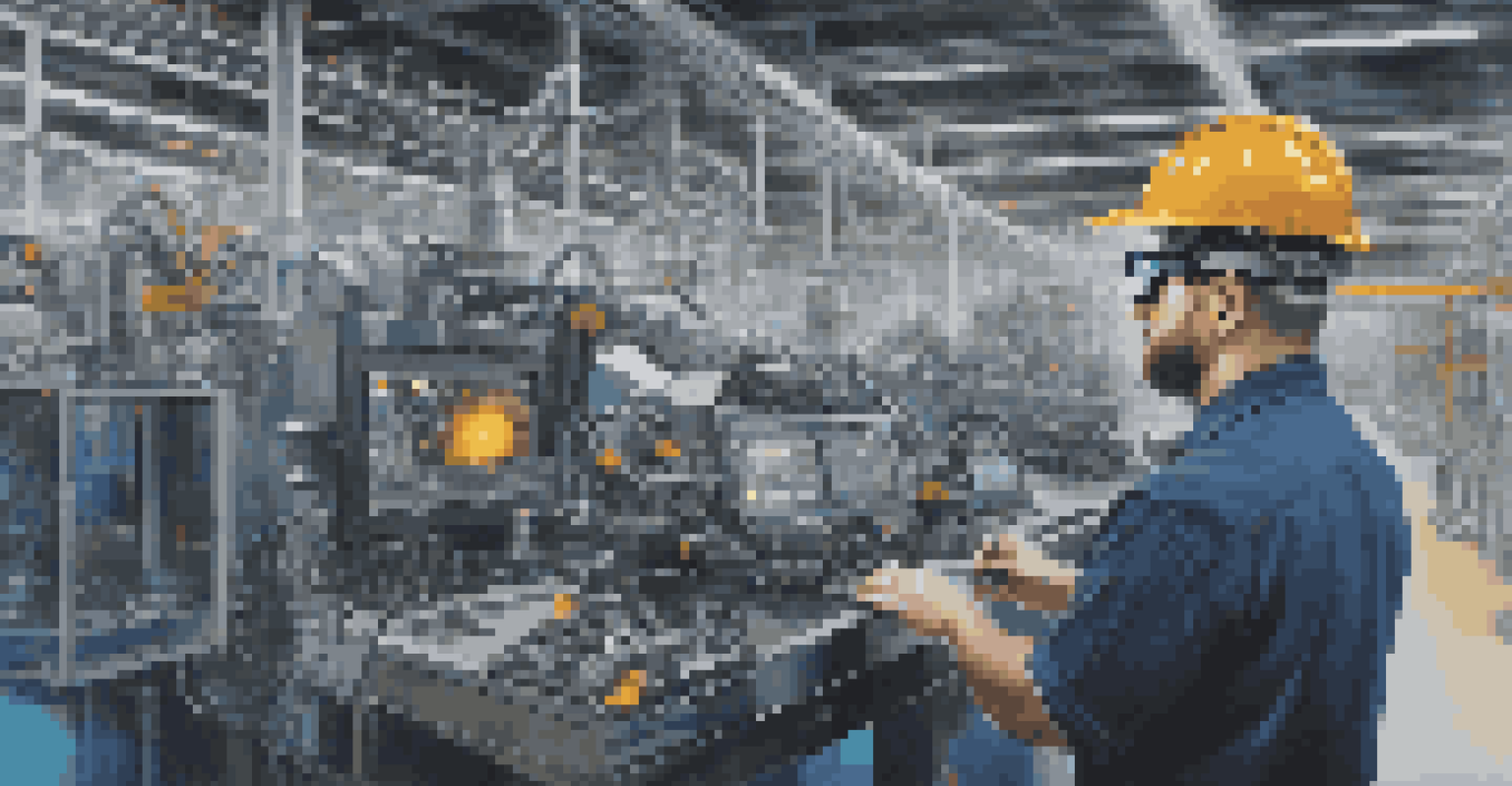AI Tools for Predictive Maintenance: A Comparative Analysis

Understanding Predictive Maintenance in Industry 4.0
Predictive maintenance is a proactive approach that leverages data analytics to anticipate equipment failures before they occur. In the context of Industry 4.0, it integrates IoT devices, sensors, and AI tools to monitor machine health continuously. This shift from reactive to predictive strategies not only minimizes downtime but also reduces maintenance costs significantly.
The goal is to turn data into information, and information into insight.
Imagine a factory where machines communicate their health status in real-time, much like how your car alerts you when it's low on fuel. This constant stream of data allows businesses to make informed decisions, optimizing maintenance schedules and improving overall efficiency. By harnessing these technologies, companies can increase their productivity while extending the lifespan of their equipment.
In summary, understanding predictive maintenance is essential for companies looking to stay competitive in today's fast-paced industrial landscape. As AI tools advance, they play a critical role in transforming how maintenance is approached, making it smarter and more efficient.
Key Benefits of Using AI Tools for Predictive Maintenance
AI tools offer numerous benefits, starting with enhanced accuracy in predicting equipment failures. By analyzing vast amounts of historical and real-time data, these tools can identify patterns and anomalies that human analysts might miss. This level of precision not only helps in scheduling maintenance more effectively but also in preventing costly breakdowns.

Additionally, AI-driven predictive maintenance can lead to significant cost savings. For instance, by addressing issues before they escalate, companies can avoid expensive emergency repairs and lost production time. This proactive approach ultimately results in a healthier bottom line, allowing resources to be allocated more efficiently.
Predictive Maintenance Defined
Predictive maintenance uses data analytics to foresee equipment failures, minimizing downtime and maintenance costs.
Moreover, the integration of AI tools fosters a culture of continuous improvement. Teams can learn from the insights generated, refining their processes and enhancing operational reliability. As a result, organizations can adapt and thrive in an ever-evolving industrial environment.
Popular AI Tools for Predictive Maintenance: An Overview
Several AI tools have emerged as frontrunners in predictive maintenance, each offering unique features suited for different industries. Tools like IBM Maximo, SAP Predictive Maintenance, and GE Digital's Predix are designed to analyze data from various sources, providing actionable insights to maintenance teams. These platforms vary in complexity, making it essential to choose one that aligns with your organization’s needs.
In the age of information, the ability to analyze and act on data is the key to success.
For example, IBM Maximo is known for its robust asset management capabilities, while SAP Predictive Maintenance excels in integrating seamlessly with existing ERP systems. GE Digital’s Predix, on the other hand, focuses heavily on industrial IoT applications, making it ideal for manufacturing and energy sectors. Each tool brings something different to the table, and understanding these distinctions can help businesses make informed choices.
In essence, the right AI tool can revolutionize how predictive maintenance is approached, enhancing both the efficiency and reliability of operations. As we explore specific tools, it becomes clear that there's no one-size-fits-all solution—each organization must assess its unique requirements.
Comparing AI Tools: Key Features to Consider
When evaluating AI tools for predictive maintenance, several key features should be top of mind. First and foremost is data integration capability; the tool should effortlessly gather data from various sources, including IoT devices, sensors, and previous maintenance records. This ensures a comprehensive view of equipment health and performance.
Another critical aspect is the user interface. A tool that is intuitive and user-friendly allows maintenance teams to easily access insights and make data-driven decisions without extensive training. Additionally, consider the level of customization the tool offers, as organizations often have unique processes and needs that require tailored solutions.
AI Tools Enhance Maintenance
AI tools improve prediction accuracy and cost savings by analyzing data to prevent costly breakdowns and enhance operational efficiency.
Lastly, robust analytics and reporting capabilities are essential for tracking performance metrics and identifying trends over time. Tools that provide clear visualizations of data can help teams communicate findings more effectively and implement improvements with confidence. By focusing on these features, businesses can select the best AI tool to enhance their predictive maintenance strategies.
Case Studies: Successful Implementation of AI Tools
Numerous companies have successfully implemented AI tools for predictive maintenance, showcasing their effectiveness across various industries. For instance, a major oil and gas company utilized GE Digital's Predix platform to monitor equipment in real-time, leading to a 20% reduction in maintenance costs. This proactive approach not only saved money but also improved operational efficiency significantly.
In the manufacturing sector, a leading automotive manufacturer adopted IBM Maximo to streamline its maintenance operations. By integrating data from multiple sources, the company was able to predict equipment failures and schedule maintenance during non-peak hours. This strategic move not only minimized disruptions but also enhanced productivity across the board.
These case studies illustrate that the implementation of AI tools can lead to transformative results, reducing costs and enhancing overall performance. By learning from these examples, other organizations can better understand the potential benefits and practical applications of predictive maintenance.
Challenges and Considerations in Adopting AI Tools
While the benefits of AI tools for predictive maintenance are compelling, there are also challenges that organizations must navigate. One significant hurdle is data quality; if the data collected from machines is inaccurate or incomplete, the predictions generated can lead to poor decision-making. Ensuring clean, reliable data is crucial for the success of any predictive maintenance strategy.
Another consideration is the integration of these tools into existing systems. Organizations may face compatibility issues with legacy systems, which can complicate the adoption process. It’s important to assess current infrastructure and identify potential gaps before implementing a new AI tool.
Challenges in AI Adoption
Organizations must address data quality, system integration issues, and workforce resistance when implementing AI tools for predictive maintenance.
Lastly, there may be resistance to change within the workforce, as employees may be hesitant to adopt new technologies. Providing adequate training and clear communication about the benefits of AI tools can help ease this transition. Addressing these challenges head-on will pave the way for a smoother implementation process and ultimately enhance the effectiveness of predictive maintenance initiatives.
The Future of Predictive Maintenance with AI Tools
As technology continues to evolve, the future of predictive maintenance looks promising, particularly with advancements in AI tools. Machine learning algorithms are becoming more sophisticated, allowing for even more accurate predictions based on historical data and real-time analytics. This evolution is likely to lead to smarter maintenance solutions that can adapt to changing conditions in real time.
Moreover, the integration of AI with augmented reality (AR) and virtual reality (VR) technologies could revolutionize the training and maintenance processes. Imagine technicians wearing AR glasses that provide real-time data overlays while they work, enhancing their ability to diagnose and fix issues on the spot. Such innovations could drastically reduce repair times and improve overall efficiency.

In conclusion, the future of predictive maintenance is bright, driven by continuous advancements in AI technology. By staying ahead of the curve and embracing these innovations, companies can ensure they remain competitive in an ever-evolving landscape, paving the way for a more efficient and reliable industrial future.